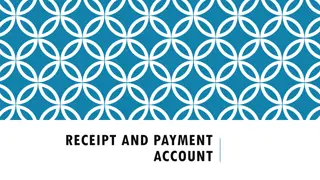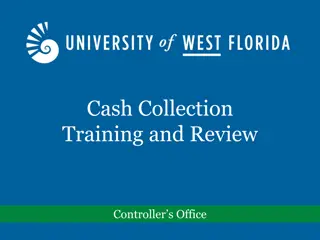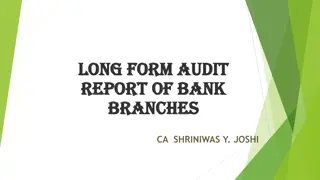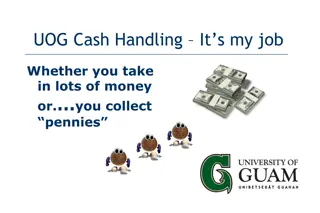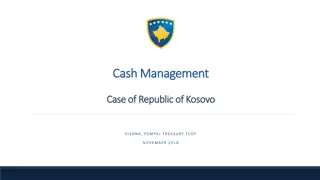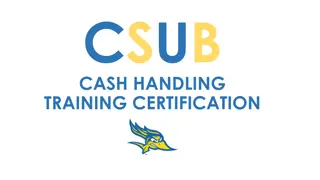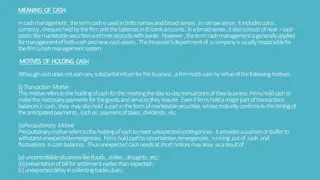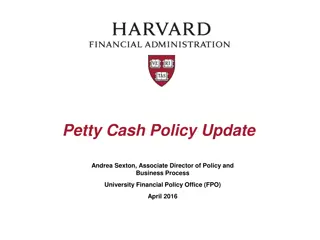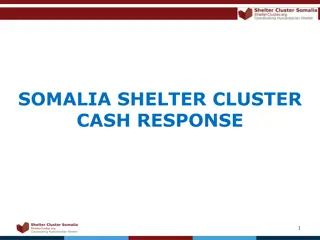Cash Management Case Studies in Policy Structure
In these case studies, explore cash management challenges faced by an exporter in Latin American countries like Argentina and Venezuela. Understand the economic crises, sovereign defaults, and changes in exchange rates affecting business operations. Find solutions to navigate financial uncertainties and optimize cash flow in challenging environments.
Download Presentation

Please find below an Image/Link to download the presentation.
The content on the website is provided AS IS for your information and personal use only. It may not be sold, licensed, or shared on other websites without obtaining consent from the author.If you encounter any issues during the download, it is possible that the publisher has removed the file from their server.
You are allowed to download the files provided on this website for personal or commercial use, subject to the condition that they are used lawfully. All files are the property of their respective owners.
The content on the website is provided AS IS for your information and personal use only. It may not be sold, licensed, or shared on other websites without obtaining consent from the author.
E N D
Presentation Transcript
Cash Management Matters 4) Case Studies in Policy Structure Dr. Barbara S. Ismail EVP, CMM Beirut, 4/29-5/1/13 1
4) Case Studies in Policy Structure Cash Management Matters 1) Summary of Facts 3) Solution / Result 2) Issues You have been approached by an exporter, exporting electronics to private companies in Brazil, Argentina and Venezuela. He has long standing relationships with his importers, whom he trusts implicitly. The government has allowed the import of his computers for the past five years, though payment has occasionally been slow. However, with the death of Hugo Chavez, he has begun to have misgivings about the solidity of Venezuela s financial system as well. Furthermore, Venezuela had supported Argentina with funds before, and he fears this will now stop. Since he does so much business in these countries, he maintains showrooms and local and foreign currency bank accounts in all three. 2
4) Case Studies in Policy Structure Cash Management Matters 1) Summary of Facts 3) Solution / Result 2) Issues SALES AND HOLDINGS IN COUNTRY Country Total Sales Per Shipment Value Merchandise in Country Bank Accounts Brazil 3,400,000 800,000 1,200,000 750,000 Argentina 5,200,000 1,000,000 1,500,000 800,000 Venezuela 900,000 250,000 300,000 400,000 3
4) Case Studies in Policy Structure Cash Management Matters 1) Summary of Facts 3) Solution / Result 2) Issues Argentina experienced the worst economic crisis in Latin American history beginning in the mid-1990s, with full recession/depression between 1999 and 2002. It is not clear whether this crisis has ended, but the situation is more stable and has improved since 2003. Argentina had a sovereign default in 2002. Capital and foreign investment stopped almost completely, and the exchange rate was floated: where it had been pegged 1:1 to the US$, the peso devalued quickly, producing higher-than-average inflation. Debt restructuring was required, as the debt was insupportable. Many creditors, both private citizens and other nations, balked at re-negotiating the debt. Argentina had almost no foreign currency reserves at the time, and for four years the country was shut out of international financial markets. Even as the economic situation improved, the amount of the debt was still the largest defaulted debt in history (about $93 billion), and Argentina was in no position to pay. Finally, the bonds were exchanged at 25-35 cents on the dollar. By 2012 holders of 6% of the debt continued to hold out, and continue to put pressure the government, recently having an Argentine Navy ship seized in Ghana. Argentina still cannot raise funds on the international markets for fear that any money raised would be impounded. Their borrowing costs are over 10%: they have been paying debt from central bank reserves, and have banned most purchases of dollars, limited imports and ordered companies to repatriate money held abroad 4
4) Case Studies in Policy Structure Cash Management Matters 1) Summary of Facts 3) Solution / Result 2) Issues Venezuela is entering a new era after the death of Hugo Chavez, President for 14 years. On 2/1/13 the Venezuelan government announced a modification of the exchange rate of the Bolivar to the US dollar, which went from 4.3 Bs/ $US to 6.3 Bs/ $US, that is, a devaluation of 46.5%: black market traders are now exchanging at 24:1. This isn t the first devaluation since 2003 and it s not the largest one. The exchange rate has gone from 1.9Bs to the US dollar, to 2.15, then in 2010 to 4.3, which has been the rate until now and which represented an increase of 100%. Shortages of basic goods continue and inflation remains above 15 percent. Oil accounts for more than 90 percent of exports, and prices of the commodity have risen ten-fold, from about $10 to $100 per barrel since 1998. Despite an oil windfall, the government's budget deficit ballooned to 17 percent last year, according to CIA figures, while public debt reached 49 percent of GDP. GDP per capita rose from $4,132 in 1999, to an estimated $11,131 in 2012, according to the IMF, while inequality decreased sharply; social spending as a % of GDP climbed from about 11 percent in 1998 to more than 21 percent in 2011, according to government statistics. Devaluation has eaten into savings and wages, and rigid currency controls were imposed in 2003. Businesses requiring access to US dollars to import products or capital goods must apply to convert to dollars for each transaction in a country dependent on imports for most aspects of daily life. 5
4) Case Studies in Policy Structure Cash Management Matters 1) Summary of Facts 3) Solution / Result 2) Issues Important Facts to Consider Argentina and Venezuela already have some level of foreign exchange restrictions in place. Will the government continue to allow the import of computers for government use? Venezuela has been thrown into some political turmoil by the death of its president, who was a polarizing factor. Currently, Brazil remains stable, and indeed, the economy is growing quickly. 6
4) Case Studies in Policy Structure Cash Management Matters Movement of Credit/Country Risk Limits ECA writes $4.5MM policy with a 10% retention by EXPORTER $4.5MM Inconvertibility Policy written to Reinsurance Treaty Export of $5MM electronics to Argentina $5MM Inconvertibility Policy purchased from ECA Lines needed by EXPORTER: $5 MM Credit on Importer $500M Country Limit Argentina $4.5 MM Limit for ECA Lines needed by EXPORTER: $5MM Credit on Importer $5MM Country Limit Argentina Lines needed by ECA: $450M Country Limit Argentina $4.05MM Credit Line for Reinsurers
4) Case Studies in Policy Structure Cash Management Matters 1) Summary of Facts 3) Solution / Result 2) Issues Ratings for Countries and Reinsurers Country Limits on Reinsurance Treaty Country S & P Rating Limit ($000)* Insurer Name Best s Rating Description Brazil A 50,000 Safety A++ Superior Argentina C 40,000 Security A Excellent Venezuela B- 15,000 Faith A- Excellent Colombia C++ 10,000 Hope B++ Good Ecuador B 20,000 Charity B Fair * Reinsurance Treaty Limit 8
4) Case Studies in Policy Structure Cash Management Matters 1) Summary of Facts 3) Solution / Result 2) Issues What are the risks you would counsel him to cover? In what amount? Is this a risk you are willing to cover? Why or why not? Do you think it will have an adverse affect on your reinsurance capacity? How would a claim affect your capital, in light of Argentina s past history? Regarding your treaties: would you keep all your reinsurers on your treaties? Why or why not? 9
4) Case Studies in Policy Structure Cash Management Matters 3) Solution / Result 1) Summary of Facts 2) Issues This client may need several coverages: CEN to cover the expropriation of bank accounts and seizure of goods in the showroom, for the amounts of the accounts and the value of showroom merchandise. In both Argentina and Venezuela, we have already seen some level of social upheaval. Argentina does not have access to funds on the international market, and further bailouts may well come with onerous conditions, leading to civil commotion and greater devaluation. 10
4) Case Studies in Policy Structure Cash Management Matters 3) Solution / Result 1) Summary of Facts 2) Issues Venezuela is already laboring under strict foreign exchange controls, with a sharply divided electorate, which may lead to civil commotion particularly by followers of Chavez. Confiscation of foreign currency denominated deposits seems a very possible scenario in both countries, as does the expropriation of goods in country. Political Unrest is also likely if the situation further deteriorates, and Argentina has little reserves to fight devaluation if it begins. 11
4) Case Studies in Policy Structure Cash Management Matters 3) Solution / Result 1) Summary of Facts 2) Issues Inconvertibility to cover the inability of any of the countries to transfer hard currency . In fact, Argentina is already in a state of quasi-inconvertibility, and Venezuela not far behind, so while this coverage is clearly warranted, it may not be a wise decision to underwrite it. Having said that, capacity for Argentine risk is full for any insurer who will take it on. And here, we come to pricing. This capacity is precious, in short supply and high demand. Top prices should be charged for it, and tenors kept to as short a time as possible. The nature of your relationship with this particular exporter should also inform whether you will use this capacity for him, or for another customer. 12
4) Case Studies in Policy Structure Cash Management Matters 1) Summary of Facts 2) Issues 3) Solution / Result If you were to write such a policy Amount of Policy should be for the amount of each shipment, ensuring each is paid for before the next goes out. In that way, a sovereign event will not catch several shipments in the channels of payment, increasing the liability for insured and insurer alike. Coverage percentages may vary in the case of particularly difficult countries, but in this example, less than the standard 90% coverage would be appropriate (perhaps 75% coverage). The exporter would keep 25% of the political risk, and 100% of the credit risk. Therefore, in a claims situation, the importer would prove he had sufficient local currency to pay even though he was prevented from transferring hard currency. 13
4) Case Studies in Policy Structure Cash Management Matters 1) Summary of Facts 2) Issues 3) Solution / Result Reinsurers must be better risks than the underlying one the policy is covering, and indeed, should be risk only of the very highest quality. Anything short of that may simply multiply your risk rather than offset it. The trade off is particularly important when comparing the relative strength of the reinsurer against the relative stability of the country/portfolio of countries being insured. The reinsurer should be significantly more solid than an insured risk. 14
4) Case Studies in Policy Structure Cash Management Matters 1) Summary of Facts 2) Issues 3) Solution / Result An insurer ranked under investment grade may be more of a risk to your capital than a country: the majority of sovereign defaults, for example, are worked out in the end even though it may take several (many) years. This is not necessarily the case for a private company. Once more, it is worthwhile to mention that the ownership of the reinsurer is of utmost importance, if it is not a publicly listed company. An insurer should strive to move the risk away from shared ownership, or the risk is not so much mitigated as moved around. 15
4) Case Studies in Policy Structure Cash Management Matters 1) Summary of Facts 2) Issues 3) Solution / Result And finally, underwriting a risk like this could prove disastrous to your reinsurance capacity: while earning premium without a claim might boost your income, any claim might well be seen as a foregone conclusion, and your underwriting judgment called into question. To underwrite this risk, you should consult with your reinsurers before taking any action, so you will be acting in concert with all in accord beforehand. Since in this case study, you were given country lines for Argentina, you may assume you have some leeway to chose to take such risk, but it should not be considered business as usual . 16
4) Case Studies in Policy Structure Cash Management Matters 1) Summary of Facts 2) Issues 3) Solution / Result ECA Responsibilities Exporters: to cover political risk and assist their business in risky nations ECA Responsible to: Shareholders: to adequately assess the risks insured, providing needed cover but not taking untoward risk on countries and currency transfer Reinsurers: to write well crafted policies which conform to the outlines set in reinsurance treaties, and to pay only valid claims 17


